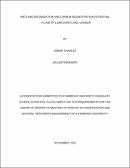| dc.contributor.author | Odeke, Charles | |
| dc.date.accessioned | 2022-03-06T11:26:31Z | |
| dc.date.available | 2022-03-06T11:26:31Z | |
| dc.date.issued | 2019-11 | |
| dc.identifier.citation | Odeke, Charles (2019) Wetland degradation and carbon sequestration potential – a case of Lubigi wetland, Uganda | en_US |
| dc.identifier.uri | https://kyuspace.kyu.ac.ug/xmlui/handle/20.500.12504/808 | |
| dc.description | xi,113 p.: ill (some col) | en_US |
| dc.description.abstract | Wetlands are known for their high carbon sequestration potential owing to their high biomass content per unit area. This is however changing due to human needs to convert them to various land use types. The aim of this study was to determine the impact of wetland degradation on carbon sequestration potentials of selected wetland degradation sites at lubigi wetland. One of the study objectives examined the use of GIS and Remote Sensing in mapping land use land cover change in Lubigi wetland between 1988 and 2018. The land cover maps were obtained from the classification of the 1988, 1995, 2001, 2010 and 2018 Landsat imagery. For the remaining three objectives; (relating carbon stocks below ground and above ground vegetation biomass across different degradation levels of wetland, establishing the relationship between selected soil physico-chemical parameters and soil carbon stocks and determining carbon sequestration potentials across different degradation levels of wetland), four sites were selected purposefully and triplicate vegetation and soil core samples were collected from each site and analyzed for above ground biomass, above ground plant carbon, and soil organic carbon contents.
The results indicated that the thick vegetation wetland had significantly higher (p<0.05) plant and soil organic carbon content than the other land use categories. The above ground plant carbon ranged between 281 g/m2 in the thick vegetation wetland to 191.8 g/m2 in the cultivated wetland. Soil organic carbon content ranged between 84.2 g/kg in the thick vegetation wetland to 27.2 g/kg in the bare land site. Soil organic carbon content was positively correlated (p<0.05) with above ground biomass and soil moisture whereas soil temperature showed significant negative correlation (p<0.05). The results showed a high reduction of organic carbon storage (sequestration) of both the soil and above ground in the disturbed areas. The mapping result indicated a progressive loss in area of Lubigi wetland to thin vegetation and build up areas. The view of the respondents from the survey also indicated the high conversion and loss of wetlands over time in the area due to population growth and urbanisation.
From the study it is concluded that carbon sequestration potential in Lubigi wetland has been progressively declining due to loss in area and degradation of wetland. It is recommended that Special attention should be given to protect all wetlands in the country so as to enhance their capacity to sequester carbon and thus mitigate climate change.
Keywords: Lubigi wetland, Degradation, Carbon sequestration, Organic carbon | en_US |
| dc.language.iso | en | en_US |
| dc.publisher | Kyambogo University (un published work) | en_US |
| dc.subject | Wetland degradation. | en_US |
| dc.subject | Carbon sequestration potential. | en_US |
| dc.subject | Lubigi wetland, Uganda | en_US |
| dc.subject | Organic carbon. | en_US |
| dc.title | Wetland degradation and carbon sequestration potential – a case of Lubigi wetland, Uganda | en_US |
| dc.type | Thesis | en_US |

